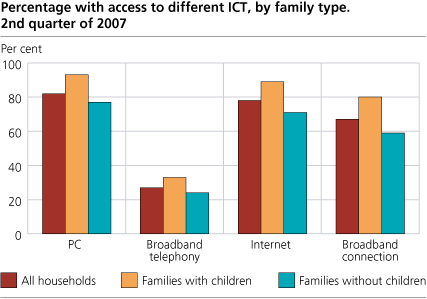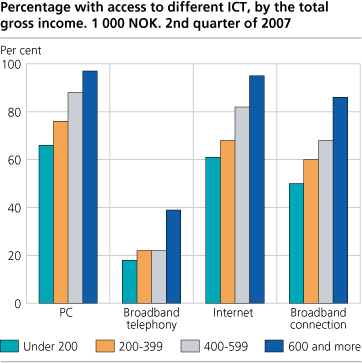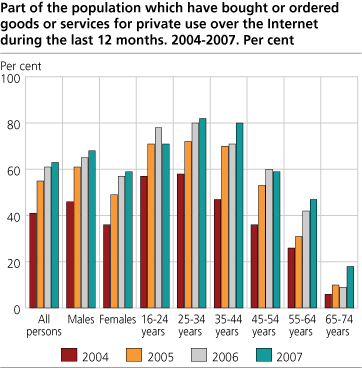Content
Published:
This is an archived release.
Two out of three households have broadband
Eight out of 10 households in Norway have access to the Internet in the second quarter of 2007. Eighty-six per cent of these subscriptions were broadband connections. Eight out of 10 households have access to a PC.
ADSL, and other DSL technologies, are the most common Internet connection in Norway. Sixty per cent have DSL in the second quarter of 2007.
Generally, families with children and families with high incomes have access to information and communication technology (ICT) more often than others. Younger people and people with higher education also have access to ICT more often than others. While 86 per cent of the households with a gross income over NOK 600 000 have broadband, the same accounts for only 50 per cent of the households with income below NOK 200 000.
Ninety per cent of the Norwegian population has used a PC in the three last months, while 73 per cent of the Norwegian population uses a PC every day. More men and more people with higher education use a PC every day.
Eighty-five per cent of the population has used the Internet during the last three months, an increase from 81 per cent in the previous year. The differences between the various groups as regards Internet use are similar to what is found in the PC use.
Twenty-six per cent of the population has no broadband connection to the Internet at home. The main reason (38 per cent) is that such access is not available in the area. Thirty-four per cent has no need for a broadband connection and 9 per cent refers to the cost involved.
The main purpose of using the Internet was searching for information or use of online services. Ninety per cent used the Internet for communication.
Slow growth in the Internet use
Disregarding the growth in Internet use connected to more Internet users, growth in the share of users that use the different Internet activities is slow. This applies to searching for information carried out by almost every Internet user. It also applies to different forms of contact with the government administration as well as Internet shopping. The part of the population that has bought or ordered goods or services for private use over the Internet during the last 12 months increased to 63 per cent from 61 per cent in the previous year. Comparable figures for the years 2005 and 2004 were 55 and 41 per cent respectively.
There is still a potential for continued growth in Internet use. Twenty-seven per cent of the population answers that they would prefer to use the Internet more than they do today. The most common reason given by 62 per cent for not using the Internet more is lack of time. Lack of own skills and knowledge is mentioned by 46 per cent and 27 per cent thinks the connection is too slow.
Many other European countries produce statistics on ICT usage in households in cooperation with EU’s statistics office Eurostat. The plan for this survey is adapted to Eurostat guidelines. Internationally comparable figures can be found here: http://epp.eurostat.cec.eu.int/portal/page?_pageid=0,1136195&_dad=portal&_schema=PORTAL .
For more information about the survey, please refer to About the statistics.
Tables:
- Table 1 Percentage with access to different ICT, by family type and household income. 2nd quarter of 2007
- Table 2 Percentage with different kinds of Internet subscriptions, by family type, household income, sex, age, education and employment situation. 2nd quarter of 2007
- Table 3 Use of computers the last 3 months, by sex, age, education and employment situation. 2nd quarter of 2007. Per cent
- Table 4 Percentage of PC users that has carried out certain PC related activities, by sex, age, education and employment situation. 2nd quarter of 2007
- Table 5 Use of the Internet, frequency and location of use last 3 months. Percentage of population, by sex, age, education and employment situation. 2nd quarter 2007
- Table 6 Purpose and nature of activities on the Internet the last 3 months. Percentage of Internet users the last 3 months, by sex, age, education and employment situation. 2nd quarter of 2007
- Table 7 Types of goods and services bought or ordered over the Internet for private use, the last 12 months, by sex and age. 2nd quarter of 2007. Per cent
- Table 8 Percentage of Internet users using e-Government, by sex, age, education and employment situation. 2nd quarter of 2007
- Table 9 Percentage without broadband and different reasons for this, by family type, household income, sex, age, education and employment situation. 2nd quarter of 2007
- Table 10 Percentage of those who would prefer to use Internet more and obstacles for more use, by sex, age, education and employment situation. 2nd quarter of 2007
Contact
-
Bruk av IKT i husholdningene
E-mail: ikthus@ssb.no



